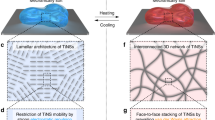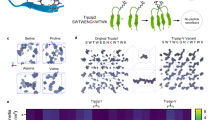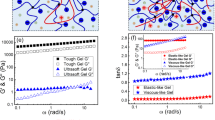Abstract
Novel soft materials should comprise multiple supramolecular nanostructures whose responses (for example, assembly and disassembly) to external stimuli can be controlled independently. Such multicomponent systems are present in living cells and control the formation and break-up of a variety of supramolecular assemblies made of proteins, lipids, DNA and RNA in response to external stimuli; however, artificial counterparts are challenging to make. Here, we present a hybrid hydrogel consisting of a self-sorting double network of nanofibres in which each network responds to an applied external stimulus independent of the other. The hydrogel can be made to change its mechanical properties and rates of release of encapsulated proteins by adding Na2S2O4 or bacterial alkaline phosphatase. Notably, the properties of the gel depend on the order in which the external stimuli are applied. Multicomponent hydrogels comprising orthogonal stimulus-responsive supramolecular assemblies would be suitable for designing novel adaptive materials.
This is a preview of subscription content, access via your institution
Access options
Access Nature and 54 other Nature Portfolio journals
Get Nature+, our best-value online-access subscription
$29.99 / 30 days
cancel any time
Subscribe to this journal
Receive 12 print issues and online access
$259.00 per year
only $21.58 per issue
Buy this article
- Purchase on SpringerLink
- Instant access to full article PDF
Prices may be subject to local taxes which are calculated during checkout






Similar content being viewed by others
Change history
29 January 2018
In the version of this Article originally published online, in Fig. 4b, in the lower-right image, the value of r was incorrect; it should have read ‘r = 0.72’. This has now been corrected in all versions of the Article.
References
Alberts, B. et al. Molecular Biology of the Cell 5th edn 965–1052 (Garland Science, New York, 2008).
Parry, D. A. D. & Squire, J. M. Fibrous Proteins: Structures and Mechanisms (Springer, 2017).
Aida, T., Meijer, E. W. & Stupp, S. I. Functional supramolecular polymers. Science 335, 813–817 (2012).
Webber, M. J., Appel, E. A., Meijer, E. W. & Langer, R. Supramolecular biomaterials. Nat. Mater. 15, 13–26 (2016).
Safont-Sempere, M. M., Fernández, G. & Würthner, F. Self-sorting phenomena in complex supramolecular systems. Chem. Rev. 111, 5784–5814 (2011).
Adler-Abramovich, L. & Gazit, E. The physical properties of supramolecular peptide assemblies: from building block association to technological applications. Chem. Soc. Rev. 43, 6881–6893 (2014).
Adhikari, B., Nanda, J. & Banerjee, A. Multicomponent hydrogels from enantiomeric amino acid derivatives: helical nanofibers, handedness and self-sorting. Soft Matt. 7, 8913–8922 (2011).
Buerkle, L. E. & Rowan, S. J. Supramolecluar gels formed from multi-component low molecular weight species. Chem. Soc. Rev. 41, 6089–6102 (2012).
Shigemitsu, H. & Hamachi, I. Supramolecular assemblies responsive to biomolecules toward biological applications. Chem. Asian J. 10, 2026–2038 (2015).
Molla, M. R., Das, A. & Ghosh, S. Self-sorted assembly in a mixture of donor and acceptor chromophores. Chem. Eur. J. 16, 10084–10093 (2010).
Smith, M. M. & Smith, D. K. Self-sorting multi-gelator gels–mixing and ageing effects in thermally addressable supramolecular soft nanomaterials. Soft Matter 7, 4856–4860 (2011).
Hirst, A. R., Eschder, B., Miravet, J. F. & Smith, D. K. High-tech applications of self-assembling supramolecular nanostructured gel-phase materials: from regenerative medicine to electronic devices. Angew. Chem. Int. Ed. 47, 8002–8018 (2008).
Raeburn, J. & Adams, D. J. Multicomponent low molecular weight gelators. Chem. Commun. 51, 5170–5180 (2015).
Görl, D., Zhang, X., Stepanenko, V. & Würthner, F. Supramolecular block copolymers by kinetically controlled co-self-assembly of planar and core-twisted perylene bisimides. Nat. Commun. 6, 7009 (2015).
Heeres, A. et al. Orthogonal self-assembly of low molecular weight hydrogelators and surfactants. J. Am. Chem. Soc. 125, 14252–14253 (2003).
Li, C. et al. Responsive double network hydrogels of interpenetrating DNA and CB[8] host–guest supramolecular systems. Adv. Mater. 27, 3298–3304 (2015).
Colquhoun, C. et al. The effect of self-sorting and co-assembly on the mechanical properties of low molecular weight hydrogels. Nanoscale 6, 13719–13725 (2014).
Pal, A., Besenius, P. & Sijbesma, R. P. Self-sorting in rodlike micelles of chiral bisurea bolaamphiphiles. J. Am. Chem. Soc. 133, 12987–12989 (2011).
Draper, E. R., Jonathan, R. L., Wallace, M., Jäckel, F., Cowan, A. J. & Adams, D. J. Self-sorted photoconductive xerogels. Chem. Sci. 7, 6499–6505 (2016).
Boekhoven, J., Koot, M., Wezendonk, T. A., Eelkema, R. & van Esch, J. H. A self assembled delivery platform with post-production tunable release rate. J. Am. Chem. Soc. 134, 12908–12911 (2012).
Morris, K. L. et al. Chemically programmed self-sorting of gelator networks. Nat. Commun. 4, 1480 (2013).
Draper, E. R., Eden, E. G. B., McDonald, T. O. & Adams, D. J. Spatially resolved multicomponent gels. Nat. Chem. 7, 848–852 (2015).
Cornwell, D. J., Daubney, O. J. & Smith, D. K. Photopatterned multidomain gels: multi-component self-assembled hydrogels based on partially self-sorting 1,3:2,4-Dibenzylidene-d-sorbitol derivatives. J. Am. Chem. Soc. 137, 15486–15492 (2015).
Singh, N. et al. Tandem reactions in self-sorted catalytic molecular hydrogels. Chem. Sci. 7, 5568–5572 (2016).
Sugiyasu, K., Kawano, S.-i, Fujita, N. & Shinkai, S. Self-sorting organogels with p–n heterojunction points. Chem. Mater. 20, 2863–2865 (2008).
Prasanthkumar, S. et al. Organic donor–acceptor assemblies form coaxial p–n heterojunctions with high photoconductivity. Angew. Chem. Int. Ed. 54, 946–950 (2015).
Cornwell, D. J. & Smith, D. K. Expanding the scope of gels – combining polymers with low-molecular weight gelators to yield modified self-assembling smart materials with high-tech applications. Mater. Horiz. 2, 279–293 (2015).
Ikeda, M. et al. Installing logic-gate responses to a variety of biological substances in supramolecular hydrogel–enzyme hybrids. Nat. Chem. 6, 511–518 (2014).
Komatsu, H. et al. Supramolecular hydrogel exhibiting four basic logic gate functions to fine-tune substance release. J. Am. Chem. Soc. 131, 5580–5585 (2009).
Onogi, S. et al. In situ real-time imaging of self-sorted supramolecular nanofibres. Nat. Chem. 8, 743–752 (2016).
Boekhoven, J. et al. Bio-inspired supramolecular materials by orthogonal self-assembly of hydrogelators and phospholipids. Chem. Sci. 7, 6021–6031 (2016).
Ikeda, M., Tanida, T., Yoshii, T. & Hamachi, I. Rational molecular design of stimulus-responsive supramolecular hydrogel based on dipeptides. Adv. Mater. 23, 2819–2822 (2011).
Shigemitsu, H. et al. Preparation of supramolecular hydrogel–enzyme hybrids exhibiting biomolecule-responsive gel degradation. Nat. Protoc. 11, 1744–1756 (2016).
Kiyonaka, S., Sugiyasu, K., Shinkai, S. & Hamachi, I. First thermally responsive supramolecular polymer based on glycosylated amino acid. J. Am. Chem. Soc. 124, 10954–10955 (2002).
Dunn, K. W., Kamocka, M. M. & McDonald, J. H. A practical guide to evaluating colocalization in biological microscopy. Am. J. Physiol. Cell Physiol. 300, C723–C742 (2011).
Tamaru, S.-i et al. Fluidic supramolecular nano- and microfibres as molecular rails for regulated movement of nanosubstances. Nat. Commun. 1, 20 (2010).
Thompson, N. L., Burghardt, T. P. & Axelrod, D. Measuring surface dynamics of biomolecules by total internal reflection fluorescence with photobleaching recovery or correlation spectroscopy. Biophys. J. 33, 435–454 (1981).
Jayaraman, K. et al. Observing capillarity in hydrophobic silica nanotubes. J. Am. Chem. Soc. 127, 17385–17392 (2005).
Matsumoto, S. et al. Photo gel–sol/sol–gel transition and its patterning of a supramolecular hydrogel as stimuli-responsive biomaterials. Chem. Eur. J. 14, 3977–3986 (2008).
Yoshii, T., Ikeda, M. & Hamachi, I. Two-photon-responsive supramolecular hydrogel for controlling materials motion in micrometer space. Angew. Chem. Int. Ed. 53, 7264–7267 (2014).
Shams Es-haghi, S. & Weiss, R. A. Fabrication of tough hydrogels from chemically cross-linked multiple neutral networks. Macromolecules 49, 8980–8987 (2016).
Acknowledgements
The authors thank M. Suginome and Y. Nagata (Kyoto University) for CD spectra measurements, N. Yamada (Kyoto Insititute of Technology) for their kind support with rheological measurements, and Y. Sato (Carl Zeiss Microimaging Co.) for CLSM imaging with the Airyscan unit. H.S. acknowledges JSPS Research Fellowships for Young Scientists (16J10716). The authors acknowledge financial support from The Mitsubishi Foundation. This work was also supported by a Grant-in-Aid for Scientific Research on Innovative Areas “Chemistry for Multimolecular Crowding Biosystems” (JSPS KAKENHI Grant No. 17H06348).
Author information
Authors and Affiliations
Contributions
H.S. and I.H. conceived the project and designed the experiments. H.S., T.F. and W.T. performed all the experiments. H.S., S.M. and K.U. analysed rheological properties. The paper was written by H.S., R.K. and I.H. and edited by all the co-authors.
Corresponding author
Ethics declarations
Competing interests
The authors declare no competing financial interests.
Additional information
Publisher’s note: Springer Nature remains neutral with regard to jurisdictional claims in published maps and institutional affiliations.
A correction to this article is available online at https://doi.org/10.1038/s41565-018-0065-7.
Supplementary information
Supplementary Information
Supplementary materials and methods, Supplementary Figures 1–36, and captions of Supplementary Videos
Videos
Supplementary Video 1
Brownian motion of 300 nm nanobeads (30 sec) in Phos-cycC6 nanofibres before and after the addition of BAP
Supplementary Video 2
Brownian motion of 300 nm nanobeads (5 min) in SDN hydrogels before and after the addition of Na2S2O4
Supplementary Video 3
Brownian motion of 300 nm nanobeads (3 h) in Na2S2O4-added SDN hydrogels before and after the addition of BAP
Supplementary Video 4
Brownian motion of 300 nm nanobeads (3 h) in SDN hydrogels before and after the addition of BAP
Supplementary Video 5
Brownian motion of 300 nm nanobeads (5 min) in BAP-treated SDN hydrogels before and after the addition of Na2S2O4
Rights and permissions
About this article
Cite this article
Shigemitsu, H., Fujisaku, T., Tanaka, W. et al. An adaptive supramolecular hydrogel comprising self-sorting double nanofibre networks. Nature Nanotech 13, 165–172 (2018). https://doi.org/10.1038/s41565-017-0026-6
Received:
Accepted:
Published:
Issue Date:
DOI: https://doi.org/10.1038/s41565-017-0026-6
This article is cited by
-
Towards edible robots and robotic food
Nature Reviews Materials (2024)
-
Tracking the enzyme-response mechanism of tannic acid-embedded chitosan/γ-polyglutamic acid hydrogel
Communications Materials (2024)
-
Four distinct network patterns of supramolecular/polymer composite hydrogels controlled by formation kinetics and interfiber interactions
Nature Communications (2023)
-
Cell spheroid creation by transcytotic intercellular gelation
Nature Nanotechnology (2023)
-
Fluorescence microscopic visualization of functionalized hydrogels
NPG Asia Materials (2022)



